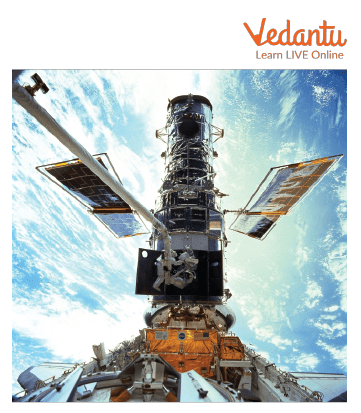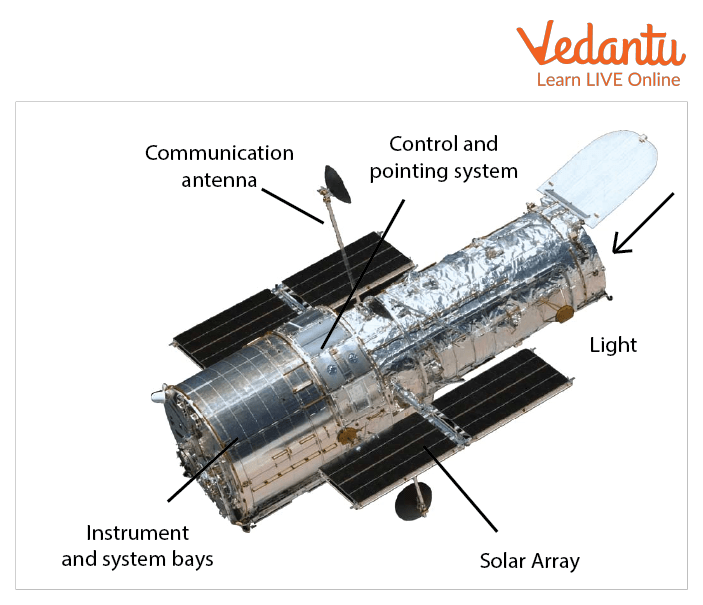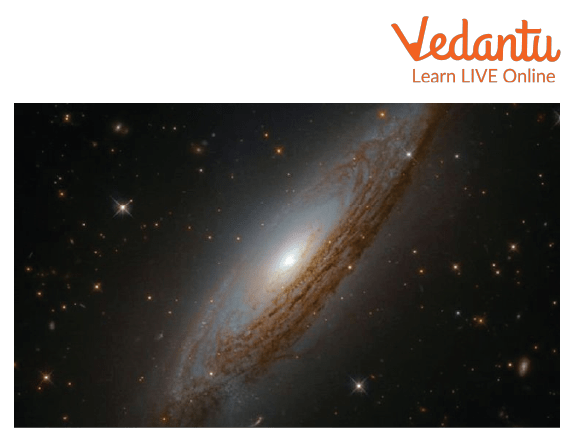




What is Hubble Telescope ?
The Hubble telescope is a space telescope. It is one of the largest and most versatile vital research tools, significant to public relations. It has proved to be a boon for astronomy. It is named after astronomer Edwin Hubble who studied distant galaxies and is NASA's one of the great observatories. It was launched into a lower orbit of Earth in 1990. Let us read ahead to learn more about this interesting piece of equipment and its function.

Hubble Space Telescope
Hubble's History
NASA's Hubble space telescope has been looking out into the universe for 30 years. In 1946, Lyman Spitzer wrote a paper about the idea of a 'large space telescope'. The first group started work on 'large space telescope' in 1974. It was launched on April 24, 1990 and was deployed on April 25. It was a joint project between NASA and the European Space Agency.
Hubble's Location
As Earth's atmosphere blocks some wavelengths and blurs Earth's telescopic images, Hubble is in orbit beyond our atmosphere to get a clearer picture than what Earth's telescope can capture. Hubble has a unique position above Earth's atmosphere which gives it incredible clarity. Hubble orbits the Earth about 340 miles above its surface and an inclination of 28.5°, where it completes 15 orbits per day, approximately one revolution every 95 minutes. Hubble has orbited 175,200 times in its 30 years of operation. As it circles above the atmosphere, it can view astronomical objects across a wider range of electromagnetic spectrum.
Working of Hubble Telescope
Hubble contains 2 mirrors-
Primary
Secondary
It is a reflecting telescope. Light hits the primary mirror and reflects to the secondary. The secondary reflects the light back through a hole in the primary, where it enters in Hubble's instruments for final focus before it hits their detectors. These instruments can detect and record three types of light: visible, ultraviolet, and infrared. Primary mirror (2.4 m in diameter) collects an immense amount of light. The space telescope can distinguish astronomical objects with an angular diameter of 0.05 arcsecond.
High resolution enables Hubble to locate such objects as dust disks around stars or the glowing nuclei of distant galaxies. It can see objects 13.4 billion light years away from Earth and revealed that the universe is about 13.8 billion years ago.

Instruments of Hubble
Solved Questions
1. How is Hubble different from the telescopes on Earth?
Ans: Hubble orbits above Earth's atmosphere which gives it a better view of the universe than telescopes at ground level.
2. Which types of wavelengths are detected by the Hubble telescope?
Ans: Hubble detects visible, near- infrared, and ultraviolet light.
3. Where is the hubble telescope now?
Ans: The Hubble telescope is currently located 535 km above the Earth surfaces.
Conclusion
The Hubble telescope is the first astronomical observatory to be placed into Earth's orbit which can record images in wavelength from ultraviolet to near infrared. It helped determine that the universe wasn't just expanding, but that the expansion was accelerating. It was a major turning point in science as it has changed humans' understanding of astronomy, led to important discoveries and many new technologies. It is designed to take high resolution pictures and accurate spectra to form sharper images than from the ground.

Picture of Black Hole Taken by Hubble
FAQs on Hubble Telescope or HST
1. What is the Hubble Space Telescope (HST)?
The Hubble Space Telescope, or HST, is a large, versatile space-based observatory. Launched in 1990, it orbits about 547 kilometres above Earth. Its location outside the planet's distorting atmosphere allows it to take extremely high-resolution images of distant stars, galaxies, and nebulae, providing a clear view into the cosmos.
2. How big is the Hubble Telescope?
The Hubble Telescope is comparable in size to a large school bus. It is approximately 13.2 meters (43.5 feet) long and weighs about 11,110 kilograms (24,500 pounds). Its main mirror, which collects light from the universe, is 2.4 meters (7.9 feet) in diameter.
3. What type of telescope is the Hubble?
The Hubble Space Telescope is a type of reflecting telescope known as a Cassegrain reflector. Instead of using lenses to bend light, it uses a large primary mirror and a smaller secondary mirror to collect and focus starlight onto its various scientific instruments, like cameras and spectrographs.
4. When was the Hubble Telescope launched and who operates it?
The Hubble Space Telescope was launched into orbit on April 24, 1990, aboard the Space Shuttle Discovery. It is a joint project between NASA (the National Aeronautics and Space Administration of the USA) and the ESA (European Space Agency).
5. What are some of the most important discoveries made by the Hubble Telescope?
The Hubble Telescope has revolutionised our understanding of the universe. Some of its most important discoveries include:
- Determining the age of the universe to be approximately 13.8 billion years.
- Providing evidence for the existence of dark energy, a mysterious force causing the universe's expansion to accelerate.
- Discovering that supermassive black holes are located at the centre of most major galaxies.
- Capturing images of the very first galaxies and stars forming in the early universe.
6. Why are Hubble's images so colourful if it takes pictures in black and white?
This is a common misconception. Hubble's cameras record light in grayscale. To create the vibrant images we see, scientists use filters to capture specific wavelengths of light, including those invisible to the human eye. They then assign different colours (like red, green, and blue) to each grayscale image from a different filter. This technique, called "false-colour imaging," helps visualise important scientific details, such as the chemical composition of a nebula.
7. How is the James Webb Space Telescope (JWST) different from the Hubble Telescope?
While both are powerful space telescopes, they are designed to observe the universe in different ways. The main differences are:
- Wavelength of Light: Hubble primarily observes in visible and ultraviolet light. JWST is optimised to see in infrared light, which allows it to see through cosmic dust clouds and peer further back in time to the universe's first stars.
- Mirror Size: JWST's primary mirror is over 6.5 meters wide, much larger than Hubble's 2.4-meter mirror, allowing it to gather significantly more light and see fainter objects.
- Orbit Location: Hubble orbits the Earth, whereas JWST orbits the Sun at a point nearly 1.5 million kilometres away from Earth.
8. Why can't the Hubble Telescope take a detailed picture of the Earth or the Sun?
Hubble's instruments are incredibly sensitive and designed to detect faint light from distant objects. Pointing it at the Sun would be like looking at a welder's torch, and the intense light would permanently damage its detectors. While it doesn't take full-disc photos of Earth because our planet moves too quickly beneath it for a clear, long-exposure image, it does use the Earth's atmosphere for calibration purposes.
9. Is the Hubble Telescope still working in 2025-26?
Yes, as of 2025-26, the Hubble Space Telescope is still fully operational and continues to conduct groundbreaking scientific research. It has received several servicing missions over the years to repair and upgrade its components. It is expected to continue its work alongside the James Webb Space Telescope for several more years, potentially into the 2030s.









